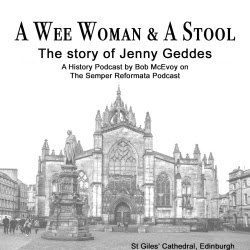Geddes had been sitting on a three legged stool, and she rushed to the front of the church and flung her stool at the Dean. Soon others joined in, and the riot began. The protest spilled over into the street, general disorder ensued and the whole service was abandoned, as the dignitaries fled to safely.
On the 3rd Sunday of July, 1637, a riot occurred in the Scottish capital city of Edinburgh, and the roots of the riot lay in a church Service in St Giles Cathedral, that ancient building that stands majestically on the Royal Mile.
Charles I was the second of the Stuart kings to straddle the thrones of England and Scotland, having ascended to the throne after his father, James 1st of England and 6th of Scotland. Charles was totally convinced that he was divinely appointed, to rule not just the nation, but to rule the church. He had a problem. In Scotland, although the populace were generally supportive of the monarchy, the influence of John Knox and the Presbyterian form of church rule that he introduced had now taken hold, and the church was governed by elders, as taught in the Bible. The elders ruled the local churches, and formed themselves into presbyteries, and held an annual general assembly to regulate the affairs of the church. There was no place in the Scottish church for Royal decrees to be proclaimed and enforced.
Charles I was the second of the Stuart kings to straddle the thrones of England and Scotland, having ascended to the throne after his father, James 1st of England and 6th of Scotland. Charles was totally convinced that he was divinely appointed, to rule not just the nation, but to rule the church. He had a problem. In Scotland, although the populace were generally supportive of the monarchy, the influence of John Knox and the Presbyterian form of church rule that he introduced had now taken hold, and the church was governed by elders, as taught in the Bible. The elders ruled the local churches, and formed themselves into presbyteries, and held an annual general assembly to regulate the affairs of the church. There was no place in the Scottish church for Royal decrees to be proclaimed and enforced.
For Charles and his advisors, this was a potentially dangerous situation. To govern the people as he wanted, Charles needed the church to be reflective of his own beliefs and policies. Since those were the days before mass media and instant news commentary, what the people heard from the pulpit was usually what shaped their beliefs and their behaviour. Just as the government today uses the media to influence society, and shape behaviour, – so Charles used the pulpits. And Charles much preferred rule to be from the top down rather than from the bottom up, with the local parishes ruled by an appointed curate or priest, who was himself ruled by a bishop, and him by an archbishop, with the king himself as the divinely appointed ruler of the church, at the head, keeping the whole ecclesiastical body in order, and so ensuring a compliant and – in his view, orderly society.
Continue here: A Wee Woman with a Stool! | The Salty Scrivener
Continue here: A Wee Woman with a Stool! | The Salty Scrivener

Comments
Post a Comment